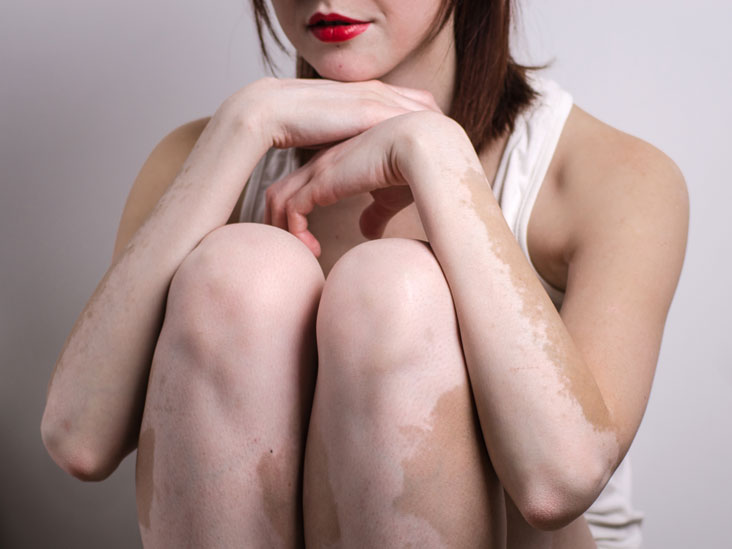Skin White / Black Spots

Patches of discolored skin are noticeable because they differ from a person’s normal skin tone. They may be lighter, darker, or a different color, such as red, gray, or blue.
Discolored skin patches have many different causes, including:
- birthmarks
- skin pigmentation disorders
- skin rashes
- skin infections
- skin cancers
- medical conditions
Birthmarks
Birthmarks are patches of discoloration that people have when they are born. Some types of birthmark fade over time, while others may be permanent.
Birthmarks are either vascular or pigmented. Vascular birthmarks are red, and they occur due to abnormal blood vessels in the skin.
Types of vascular birthmark include:
- Strawberry nevus. Also called a hemangioma, this is a common type of vascular birthmark. It appears as a red patch and is most common on the face, scalp, chest, and back. A strawberry nevus does not usually require treatment.
- Salmon patch. Also called a nevus simplex, this flat red or pink patch of skin typically occurs on the neck or forehead. Up to 40 percent of all babies are born with this type of birthmark.
- Port wine stain. This is a noticeable flat red or purple birthmark. Some port wine stains may require treatment, which might include laser treatment or cosmetic camouflage.
Pigmented birthmarks are generally white, brown, blue, or gray. They result from a problem with the melanin in the skin.
Types of pigmented birthmark include:
- Mongolian blue spots. These are blue or gray patches that may be present on the back and buttocks at birth. Babies with darker skin are more likely to have these birthmarks. Mongolian blue spots often fade as the child grows.
- Moles. These are black or brown spots that are usually harmless. However, it is best to see a doctor if a mole changes shape, size, or texture.
- Café-au-lait spot. These appear as light brown skin patches on light skin or black coffee-colored patches on dark skin. Café-au-lait spots are often oval-shaped and may fade as the child grows.
Skin pigmentation disorders
If a person has lighter or darker skin patches, this may signify a skin pigmentation disorder. Type of skin pigmentation disorder include:
Melasma. This is a common skin condition that usually affects facial skin and causes brown patches. It affects women more often than men. Triggers of melasma can include sun exposure and hormonal changes.
Vitiligo. This disease can affect any part of the body. It causes the cells that produce melanin, known as melanocytes, to stop working correctly, which results in patches of lighter skin. Sometimes, it will also change a person’s hair color. The exact cause of vitiligo is unknown, but a problem with the immune system may be responsible.
Post-inflammatory hyperpigmentation or hypopigmentation. This is a temporary increase or decrease in skin pigment following skin trauma, such as a blister or burn.
Albinism. People with albinism do not produce enough melanin. This leads to little or no pigment in the skin, hair, or eyes. Albinism is a genetic disorder, meaning that a person inherits a faulty gene from one or both of their parents.
Skin rashes
Some types of skin rash can also cause patches of discolored skin. These include:
- Rosacea. This is a chronic skin condition that can cause raised patches of red skin and pus-filled lesions. It typically affects the forehead, cheeks, and nose.
- Psoriasis. This is a skin condition that causes silvery-red, crusty, flaky patches of skin, which can appear anywhere on the body. Doctors believe that psoriasis may result from a problem with the immune system.
- Contact dermatitis. This rash happens when the skin reacts to an irritant or allergen.
- Eczema. Also known as atopic dermatitis, this condition can cause patches of red skin that is also itchy, dry, and cracked. These patches may sometimes ooze and then form a crust. The cause of eczema is unclear, but it can run in families and is more common in people who have asthma, hay fever, and other allergies.
Certain skin infections may also cause discoloration, such as:
- Tinea versicolor. This is a fungal skin infection that can cause patches of skin to become lighter or darker. These patches usually develop slowly and can sometimes merge to form larger patches. Tinea versicolor tends to affect the trunk, neck, and upper arms.
- Ringworm. Also known as tinea, this is a fungal skin infection that causes red or silver ring-shaped patches of skin. These patches may be scaly, dry, or itchy. Ringworm can appear on most parts of the body, including the scalp, groin, feet, hands, and nails.
- Candidiasis of the skin. This is a fungal skin infection that causes red, itchy skin patches. It often occurs in areas where the skin folds, such as the armpits and groin.
Skin cancers
In rare cases, skin cancer can cause patches of discoloration. Types of skin cancer include:
- Actinic keratosis. These are dry, scaly, pre-cancerous skin patches. Without treatment, they may progress to squamous cell carcinoma.
- Basal cell carcinoma. These are flesh-colored, pearl-like, pink skin patches or bumps. Basal cell carcinomas are the most common form of skin cancer.
- Squamous cell carcinoma. These are red bumps, sores, or scaly patches, which may heal and then re-open. Squamous cell carcinomas are the second most common type of skin cancer.
- Melanoma. This cancer may develop in existing moles or appear as new dark spots. Melanomas are the most severe form of skin cancer, and early diagnosis and prompt treatment are crucial.
